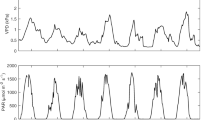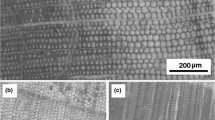Abstract
Key message
Our study shows that sap flow in Avicennia marina varies significantly throughout the sapwood and that spatial patterns in sap flux density are dependent on meteorological conditions.
Abstract
Sap flux density measurements are used worldwide as a relatively inexpensive means to provide estimates of whole-tree and whole-stand water use in forest ecosystems. However, erroneous upscaling from point measurements to the entire sapwood area remains an issue, since sap flow is hardly ever constant throughout the tree. In this study, two widely used sap flow methodologies (the Heat Ratio or HR method and the Heat Field Deformation or HFD method) are used to assess radial and azimuthal variations in sap flux density in three mature trees of the mangrove species Avicennia marina in Brisbane, Australia. The genus Avicennia is characterised by secondary growth via successive cambia, resulting in an atypical sapwood pattern of xylem patches braided with phloem strings. Water use estimates were calculated in different ways. At first, spatial variation was ignored when upscaling from point measurements. Then, radial and azimuthal variations were incorporated subsequently by measuring at different depths and aspects around the tree. Ignoring azimuthal variation led to over- or underestimations of up to 102 %, while radial variation accounted for discrepancies of up to 25 %. Furthermore, the influence of changing meteorological conditions was assessed, which showed that radial profiles changed in shape during rain events, such that maximum sap flow rates occurred at different depths compared to dry periods. Our study thus indicates that spatial variation in sap flux density is highly unpredictable in A. marina due to its hydraulic architecture, and that changing meteorological conditions alter the pattern of this variation. These two factors should be accounted for when assessing whole-tree water use.





Similar content being viewed by others
References
Alvarado-Barrientos MS, Hernandez-Santana V, Asbjornsen H (2013) Variability of the radial profile of sap velocity in Pinus patula from contrasting stands within the seasonal cloud forest zone of Veracruz, Mexico. Agric For Meteorol 168:108–119
Barrett DJ, Hatton TJ, Ash JE, Ball MC (1996) Transpiration by trees from contrasting forest types. Aust J Bot 44:249–263
Becker P, Asmat A, Mohamad J, Moksin M, Tyree MT (1997) Sap flow rates of mangrove trees are not unusually low. Trees-Struct Funct 11:432–435
Burgess SSO, Adams MA, Turner NC, Beverly CR, Ong CK, Khan AAH, Bleby TM (2001) An improved heat pulse method to measure low and reverse rates of sap flow in woody plants. Tree Physiol 21:589–598
Cohen Y, Cohen S, Cantuarias-Aviles T, Schiller G (2008) Variations in the radial gradient of sap velocity in trunks of forest and fruit trees. Plant Soil 305:49–59
Cohen S, Wheeler J, Holbrook NM (2012) The radial and azimuthal (or tangential) distribution of sap velocity in tree stems—why and can we predict it? In: Sebastiani L, Tognetti R, Motisi A (eds) VIII international symposium on sap flow. International society for horticultural science, Leuven, pp 131–137
Delzon S, Sartore M, Granier A, Loustau D (2004) Radial profiles of sap flow with increasing tree size in maritime pine. Tree Physiol 24:1285–1293
Dragoni D, Lakso AN, Piccioni RM (2005) Transpiration of apple trees in a humid climate using heat pulse sap flow gauges calibrated with whole-canopy gas exchange chambers. Agric For Meteorol 130:85–94
Fiora A, Cescatti A (2006) Diurnal and seasonal variability in radial distribution of sap flux density: implications for estimating stand transpiration. Tree Physiol 26:1217–1225
Ford CR, McGuire MA, Mitchell RJ, Teskey RO (2004) Assessing variation in the radial profile of sap flux density in Pinus species and its effect on daily water use. Tree Physiol 24:241–249
Gebauer T, Horna V, Leuschner C (2008) Variability in radial sap flux density patterns and sapwood area among seven co-occurring temperate broad-leaved tree species. Tree Physiol 28:1821–1830
Goldstein G, Andrade JL, Meinzer FC, Holbrook NM, Cavelier J, Jackson P, Celis A (1998) Stem water storage and diurnal patterns of water use in tropical forest canopy trees. Plant, Cell Environ 21:397–406
Hatton TJ, Moore SJ, Reece PH (1995) Estimating stand transpiration in a Eucalyptus populnea woodland with the heat pulse method—measurement errors and sampling strategies. Tree Physiol 15:219–227
Krauss KW, Young PJ, Chambers JL, Doyle TW, Twilley RR (2007) Sap flow characteristics of neotropical mangroves in flooded and drained soils. Tree Physiol 27:775–783
Kubota M, Tenhunen J, Zimmermann R, Schmidt M, Adiku S, Kakubari Y (2005) Influences of environmental factors on the radial profile of sap flux density in Fagus crenata growing at different elevations in the Naeba Mountains, Japan. Tree Physiol 25:545–556
Kume T, Otsuki K, Du S, Yamanaka N, Wang Y-L, Liu G-B (2012) Spatial variation in sap flow velocity in semiarid region trees: its impact on stand-scale transpiration estimates. Hydrol Process 26:1161–1168
Lopez-Bernal A, Alcantara E, Testi L, Villalobos FJ (2010) Spatial sap flow and xylem anatomical characteristics in olive trees under different irrigation regimes. Tree Physiol 30:1536–1544
Lu P, Muller WJ, Chacko EK (2000) Spatial variations in xylem sap flux density in the trunk of orchard-grown, mature mango trees under changing soil water conditions. Tree Physiol 20:683–692
Mencuccini M, Grace J (1995) Climate influences the leaf-area sapwood area ratio in Scots pine. Tree Physiol 15:1–10
Muller E, Lambs L, Fromard F (2009) Variations in water use by a mature mangrove of Avicennia germinans, French Guiana. Ann For Sci 66:803
Nadezhdina N, Cermak J, Nadezhdin V (1998) The Heat Field Deformation method for sap flow measurement. In: Cermak J, Nadezhdina N (eds) Proceedings of the 4th international workshop on measuring sap flow in intact plants. Publishing House of Mendel University, Czech Republic, pp 72–92
Nadezhdina N, Cermak J, Ceulemans R (2002) Radial patterns of sap flow in woody stems of dominant and understory species: scaling errors associated with positioning of sensors. Tree Physiol 22:907–918
Nadezhdina N, Nadezhdin V, Ferreira MI, Pitacco A (2007) Variability with xylem depth in sap flow in trunks and branches of mature olive trees. Tree Physiol 27:105–113
Nadezhdina N, Steppe K, De Pauw DJW, Bequet R, Cermak J, Ceulemans R (2009) Stem-mediated hydraulic redistribution in large roots on opposing sides of a Douglas-fir tree following localized irrigation. New Phytol 184:932–943
Nadezhdina N, Vandegehuchte MW, Steppe K (2012) Sap flux density measurements based on the heat field deformation method. Trees-Struct Funct 26:1439–1448
Oren R, Phillips N, Ewers BE, Pataki DE, Megonigal JP (1999) Sap-flux-scaled transpiration responses to light, vapor pressure deficit, and leaf area reduction in a flooded Taxodium distichum forest. Tree Physiol 19:337–347
Phillips N, Oren R, Zimmermann R (1996) Radial patterns of xylem sap flow in non-, diffuse- and ring-porous tree species. Plant, Cell Environ 19:983–990
Poyatos R, Cermak J, Llorens P (2007) Variation in the radial patterns of sap flux density in pubescent oak (Quercus pubescens) and its implications for tree and stand transpiration measurements. Tree Physiol 27:537–548
Robert EMR, Schmitz N, Boeren I, Driessens T, Herremans K, De Mey J, Van de Casteele E, Beeckman H, Koedam N (2011) Successive cambia: a developmental oddity or an adaptive structure? Plos One 6:e16558
Roberts J (2007) The role of plant physiology in hydrology: looking backwards and forwards. Hydrol Earth Syst Sci 11:256–269
Saveyn A, Steppe K, Lemeur R (2008) Spatial variability of xylem sap flow in mature beech (Fagus sylvatica) and its diurnal dynamics in relation to microclimate. Bot Botanique 86:1440–1448
Schiller G, Cohen Y (1995) Water regime of a pine forest under a mediterranean climate. Agric For Meteorol 74:181–193
Schmitz N, Verheyden A, Kairo JG, Beeckman H, Koedam N (2007) Successive cambia development in Avicennia marina (Forssk.) Vierh. is not climatically driven in the seasonal climate at Gazi Bay. Kenya. Dendrochronologia 25:87–96
Schmitz N, Robert EMR, Verheyden A, Kairo JG, Beeckman H, Koedam N (2008) A patchy growth via successive and simultaneous cambia: key to success of the most widespread mangrove species Avicennia marina? Ann Bot (Lond) 101:49–58
Shinohara Y, Tsuruta K, Ogura A, Noto F, Komatsu H, Otsuki K, Maruyama T (2013) Azimuthal and radial variations in sap flux density and effects on stand-scale transpiration estimates in a Japanese cedar forest. Tree Physiol 33:550–558
Spalding M, Kainuma M, Collins L (2010) World atlas of mangroves. Earthscan, London
Steppe K, De Pauw DJW, Saveyn A, Tahon P, Nadezhdina N, Cermak J, Lemeur R (2009) Radial sap flux profiles and beyond: an easy software analysis tool. In: Fernandez E, Diaz Espejo A (eds) VII international workshop on sap flow. International Society for Horticultural Science, Leuven, pp 85–91
Steppe K, De Pauw DJW, Doody TM, Teskey RO (2010) A comparison of sap flux density using thermal dissipation, heat pulse velocity and heat field deformation methods. Agric For Meteorol 150:1046–1056
Tateishi M, Kumagai T, Utsumi Y, Umebayasi T, Shiiba Y, Inoue K, Kaji K, Cho K, Otsuki K (2008) Spatial variations in xylem sap flux density in evergreen oak trees with radial-porous wood: comparisons with anatomical observations. Trees-Struct Funct 22:23–30
Tsuruta K, Kume T, Komatsu H, Higashi N, Umebayashi T, To Kumagai, Otsuki K (2010) Azimuthal variations of sap flux density within Japanese cypress xylem trunks and their effects on tree transpiration estimates. J For Res 15:398–403
Wullschleger SD, King AW (2000) Radial variation in sap velocity as a function of stem diameter and sapwood thickness in yellow-poplar trees. Tree Physiol 20:511–518
Wullschleger SD, Meinzer FC, Vertessy RA (1998) A review of whole-plant water use studies in trees. Tree Physiol 18:499–512
Zamski E (1979) The mode of secondary growth and the three-dimensional structure of the phloem in Avicennia. Bot Gaz 140:67–76
Author contribution statement
BAEVdW did the analysis and interpretation of the data, and wrote the paper. BAEVdW and AG performed the experiments and processed the measured data. CEL, DAL and KS designed the study. All authors commented on the manuscript.
Acknowledgments
The authors wish to thank the Agency for Innovation by Science and Technology in Flanders (IWT) for the PhD funding granted to BAEVdW and the Scientific Research Committee (CWO), Faculty of Bioscience Engineering, Ghent University, Belgium for the travel grant allotted to BAEVdW. The authors also wish to thank ICT International, Armidale, NSW, Australia for the technical support with the equipment and Mothei Lenkopane and Kasper Oestergaard for their assistance during the field work. Furthermore, the authors wish to thank the anonymous reviewers for their comments, which helped to improve the manuscript.
Conflict of interest
The authors declare that they have no conflict of interest.
Author information
Authors and Affiliations
Corresponding author
Additional information
Communicated by A. Braeuning.
Rights and permissions
About this article
Cite this article
Van de Wal, B.A.E., Guyot, A., Lovelock, C.E. et al. Influence of temporospatial variation in sap flux density on estimates of whole-tree water use in Avicennia marina . Trees 29, 215–222 (2015). https://doi.org/10.1007/s00468-014-1105-z
Received:
Revised:
Accepted:
Published:
Issue Date:
DOI: https://doi.org/10.1007/s00468-014-1105-z




